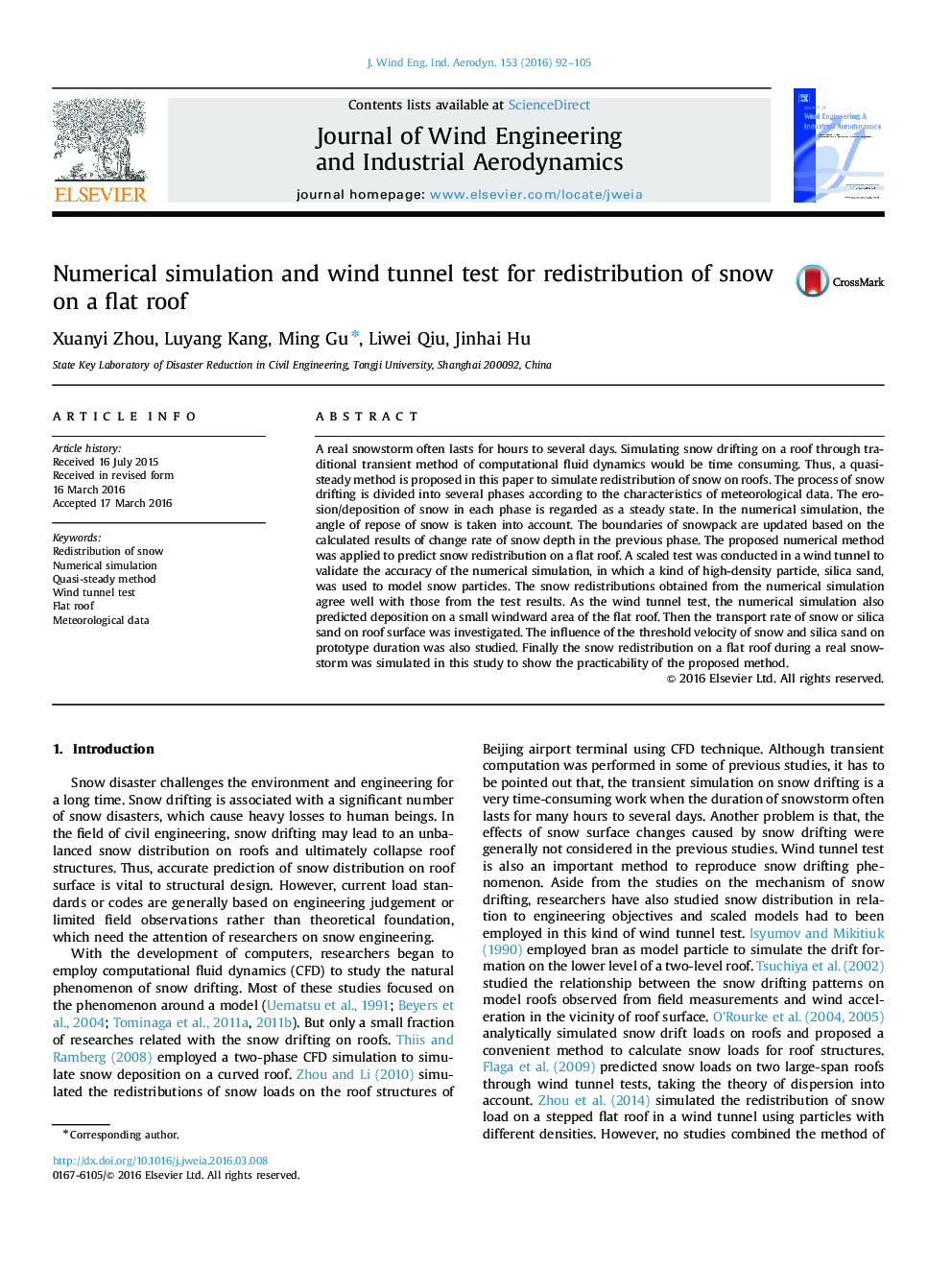| کد مقاله | کد نشریه | سال انتشار | مقاله انگلیسی | نسخه تمام متن |
|---|---|---|---|---|
| 6757360 | 511047 | 2016 | 14 صفحه PDF | دانلود رایگان |
عنوان انگلیسی مقاله ISI
Numerical simulation and wind tunnel test for redistribution of snow on a flat roof
ترجمه فارسی عنوان
شبیه سازی عددی و آزمایش تونل باد برای توزیع برف بر روی سقف تخت
دانلود مقاله + سفارش ترجمه
دانلود مقاله ISI انگلیسی
رایگان برای ایرانیان
کلمات کلیدی
توزیع برف، شبیه سازی عددی، روش نیمه ثابت، آزمون تونل باد، سقف تخت، داده های هواشناسی،
ترجمه چکیده
یک بارش برف واقعی معمولا برای چند ساعت تا چند روز طول می کشد. شبیه سازی بارش برف روی یک سقف از طریق روش سنتی گذار از پویایی سیال محاسباتی زمان زیادی را صرف خواهد کرد. بنابراین، در این مقاله یک روش نیمه ثابت برای شبیه سازی توزیع برف بر روی سقف پیشنهاد شده است. روند بارش برف با توجه به ویژگی های داده های هواشناسی به چند مرحله تقسیم می شود. فرسایش / رسوب برف در هر مرحله به عنوان یک حالت پایدار در نظر گرفته می شود. در شبیه سازی عددی، زاویه خواب از برف در نظر گرفته شده است. محدوده برف پک بر اساس نتایج محاسبه شده تغییر نرخ عمق برف در فاز قبلی به روز می شود. روش پیشنهادی عددی برای پیش بینی توزیع برف بر روی سقف تخت استفاده شده است. یک تست مقیاس سنجی در یک تونل باد برای تأیید صحت شبیه سازی عددی انجام شد که در آن نوع ذرات با چگالی بالا، شن و ماسه سیلیس برای مدلسازی ذرات برف استفاده شد. توزیع برف به دست آمده از شبیه سازی عددی به خوبی با نتایج حاصل از آزمون همخوانی دارد. به عنوان آزمایش تونل باد، شبیه سازی عددی نیز رسوب را در یک ناحیه کوچک تاجی از سقف تخت پیش بینی کرد. سپس میزان حمل و نقل شن و ماسه برف و سیلیس در سطح سقف مورد بررسی قرار گرفت. اثر سرعت آستانه شن و ماسه برف و سیلیس در مدت زمان نمونه گیری نیز مورد بررسی قرار گرفت. در نهایت، بازتوزیع برف بر روی یک سقف تخت در طول یک برف واقعی، در این مطالعه شبیه سازی شده است تا قابلیت انجام روش پیشنهادی را نشان دهد.
موضوعات مرتبط
مهندسی و علوم پایه
مهندسی انرژی
انرژی های تجدید پذیر، توسعه پایدار و محیط زیست
چکیده انگلیسی
A real snowstorm often lasts for hours to several days. Simulating snow drifting on a roof through traditional transient method of computational fluid dynamics would be time consuming. Thus, a quasi-steady method is proposed in this paper to simulate redistribution of snow on roofs. The process of snow drifting is divided into several phases according to the characteristics of meteorological data. The erosion/deposition of snow in each phase is regarded as a steady state. In the numerical simulation, the angle of repose of snow is taken into account. The boundaries of snowpack are updated based on the calculated results of change rate of snow depth in the previous phase. The proposed numerical method was applied to predict snow redistribution on a flat roof. A scaled test was conducted in a wind tunnel to validate the accuracy of the numerical simulation, in which a kind of high-density particle, silica sand, was used to model snow particles. The snow redistributions obtained from the numerical simulation agree well with those from the test results. As the wind tunnel test, the numerical simulation also predicted deposition on a small windward area of the flat roof. Then the transport rate of snow or silica sand on roof surface was investigated. The influence of the threshold velocity of snow and silica sand on prototype duration was also studied. Finally the snow redistribution on a flat roof during a real snowstorm was simulated in this study to show the practicability of the proposed method.
ناشر
Database: Elsevier - ScienceDirect (ساینس دایرکت)
Journal: Journal of Wind Engineering and Industrial Aerodynamics - Volume 153, June 2016, Pages 92-105
Journal: Journal of Wind Engineering and Industrial Aerodynamics - Volume 153, June 2016, Pages 92-105
نویسندگان
Xuanyi Zhou, Luyang Kang, Ming Gu, Liwei Qiu, Jinhai Hu,
